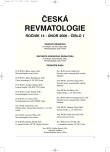Diffuse idiopathic skeletal hyperostosis (DISH) and ossification of posterior longitudinal ligament (OPLL) - metabolic and genetic factors
Authors:
A. Pavelková; Š. Forejtová; K. Pavelka
Authors‘ workplace:
Revmatologický ústav Praha
Published in:
Čes. Revmatol., 14, 2006, No. 1, p. 17-21.
Category:
Overview Reports
Overview
Diffuse idiopathic skeletal hyperostosis (DISH) is a non-inflammatory disease characterized by hyperostosis of the axial as well as peripheral skeleton. Its association with diabetes mellitus type II and other metabolic disorders (an impaired lipid profile) has been known for a long time, although the context is not known yet. Hyperglycemia and insulin resistance, then the role of substances that are related to the growth hormones (GF) and mediated by insulin-like growth hormones (IGF) and theirs bindings proteins (IGFBP2, IGFBP3) seem to play an important role in this disease. Genetic factors (collagen type 6 gene COL6A1) could also represent a significant role in the etiology of DISH, such as suggested for a similar entity - ossification of posterior longitudinal ligament (OPLL).
Key words:
DISH, hyperostosis, diabetes mellitus, insulin resistance, OPLL, COL6A1
Labels
Dermatology & STDs Paediatric rheumatology RheumatologyArticle was published in
Czech Rheumatology

2006 Issue 1
Most read in this issue
- Diffuse idiopathic skeletal hyperostosis (DISH) and ossification of posterior longitudinal ligament (OPLL) - metabolic and genetic factors
- Uncommon coincidence of Charcot osteoarthropathy with enteropathic arthritis
- The significance of Borrelia burgdorferi DNA investigation in a diagnostic algorithm of Lyme arthritis
- Modulation of bone turnover by glucocorticoid treatment
